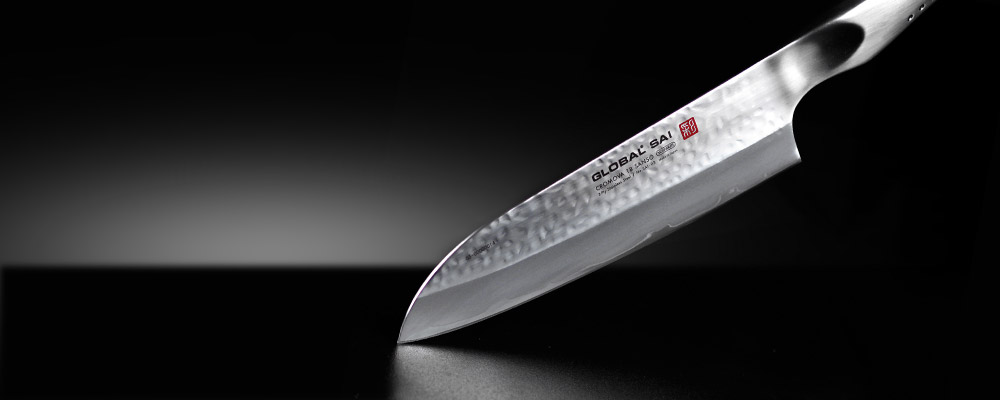
Samurai traditionA thousand years ago, Japanese blacksmiths developed the art of the sword in order to offer strong and very sharp blades to the Samurai, the warrior caste. After the ban on the wearing of the saber, these blacksmiths were forced to retrain. Today, continuing on the tradition of the samurai sword, Japanese artisans produce high quality GLOBAL knives , these are made by Yoshikin in Niigata, Japan. | In the beginningThe GLOBAL kitchen @4O3H4 were first designed in 1985 by Komin Yamada. When Komin Yamada took on this task his mandate was to develop a range of truly new and revolutionary knives, using the best available materials and the latest manufacturing techniques. His goal was to create a series of kitchen knives that would be appreciated by professional chefs as well as by amateurs, these knives had to be comfortable and easy to handle, and meet their most demanding needs. |
Knives characteristics GLOBAL
The most important characteristic of any knife is its sharpness, and the GLOBAL edge is truly its signature. The majority of Global knives are sharp or sharp on both sides of the blade, just like western style knives. However, their edges are sharpened at a sharp angle and at an acute angle. This is in contrast to Western or European knives which use a beveled edge - straight line sharpening provides a considerably sharper knife and stays sharp for much longer. The edge on a GLOBAL knife is so large and large that it is easily visible to the naked eye and extends a quarter of an inch to the top of the knife tip. To balance their knives, Global uses a hollow handle which is then filled with just the right amount of sand to create the right balance. Global uses this method rather than using a full flavor and bolster to balance their knives for two reasons:
Other unique features of Global knives are their smooth, seamless contours, made entirely of stainless steel which remove food traps and dirt which provide the ultimate in safety and hygiene. Discover the whole range of accessories and knives Global at the best prices ! |
How are Japanese knives made?
The GLOBAL knives are made from the finest high carbon stainless steel available for making professional kitchen knives. Yoshikin uses its own patented stainless steel called CROMOVA 18 stainless steel, this material was designed exclusively for Global knives. This steel is hard enough to allow Global knives to be very strong and maintain their sharpness ... but soft enough that it is not too difficult to sharpen them.
The CRO in CROMOVA 18 represents chromium and the 18 is the percentage of chromium in the steel.
The MO and VA in CROMOVA 18 are the initials for molybdenum and vanadium, which are two metallic elements that give GLOBAL knives an excellent edge.
It is often asked why Global knives stay sharp for so long without sharpening. The combination of the elements molybdenum and vanadium is one of these reasons, but also returning to the diagrams above, for the advantage of the straight edge against the beveled edge.
How to maintain the Global knives?
The maintenance is very simple. Note that Global knives have a better longevity than traditional knives. A Global knife, even with heavy professional use will last a lifetime if properly maintained.
We recommend cleaning the GLOBAL knives by hand with washing up liquid and hot water.
Rinse with clean water and wipe dry with a soft cloth.
IMPORTANT: Do not put the GLOBAL knives in the dishwasher.
For easier storage, opt for a knife Global
How do I sharpen a Global knife?
Sharpening can be done with the universal manual sharpener , specially designed to maintain your Japanese knives or the sharpening stone Global for perfect precision.
Immerse your original Japanese sharpening stone in water for about 10 minutes so that it is well saturated. Important: the stone must always be damp during sharpening. Water acts as a lubricant, so it should be moistened regularly. The sharpening angle is usually 15 to 20 degrees from the whetstone.
Then in a movement going from the outside to the inside exert a light pressure to slide the knife six to ten times on the stone to be sharpened.
A powdery mass appears and promotes the sharpening process. Finally, rinse your knife with hot water and dry it with a soft cloth.
Caution: You cannot sharpen knives with serrated edges (bread knife for example) with a sharpening stone.
(Single-edged knives should be sharpened 80% at the front and 20% at the rear; for double edges 70% at the front and 30% at the rear.)
Please note: The Global double-edged knives are designed for right-handed @9U3N4 , i.e. sharp on the right side at 70% and on the left side at 30%. It will therefore be necessary to sharpen 7 x on the right and 3 x on the left the right-handers, the opposite for the left-handers.
Consider personalizing your knife to make it unique!
For a gift or just to treat yourself, laser engraving is ideal to make your knife unique and personal. You can choose the size and style of the inscription by indicating your name, your initials, or even a nice little message! Let your imagination run wild ... The online personalization tool is very simple, it's up to you! (paying option 8 € 50 per knife)
